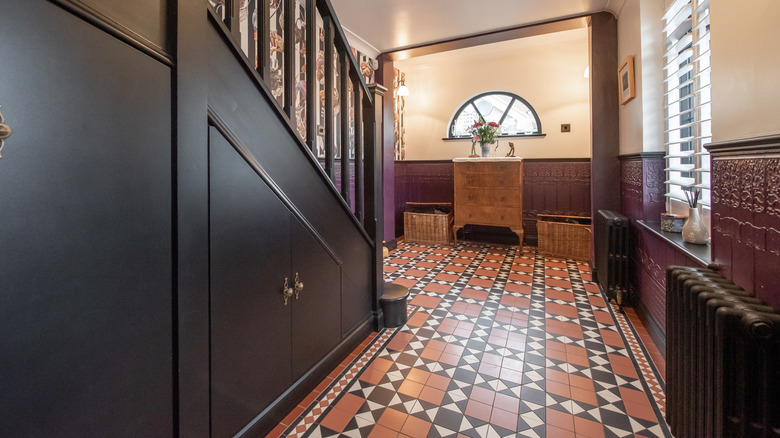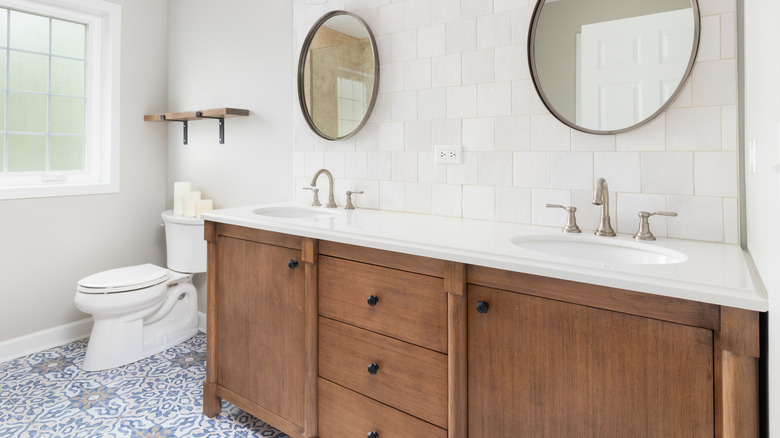How To Restore Beautiful Victorian Tile In Your Home
We may receive a commission on purchases made from links.
Historic homes are often filled with unique architectural elements that are just waiting to be uncovered, adding to their highly sought-after charm. Even creaky floorboards and vintage hardware contribute to the overall feel of these homes. One of the most stunning historic home design trends is the original Victorian tiles. With vibrant colors and intricate geometric designs, this flooring highlights the craftsmanship of the era to create a timeless focal point around your space. But, while they may be a welcome addition to your home, these historical pieces often need a bit of TLC to get them presentable. If you're trying to restore beautiful Victorian tile in your home, there are a few tips that can help revive these unique pieces, preserving them for years to come.
This DIY restoration job starts with cleaning your Victorian tiled floor. You'll want to begin with a thorough sweep and vacuum of the full surface area before getting into the actual tile work. For this step, you can either use dish soap with a bit of water or some baking soda. Avoid any abrasive cleaners or harsh chemicals, as they may damage the delicate tiles. Use a soft brush or wet rag to get at any lasting stains that may be on your tiles or inside the grout lines. Rinse the area with a bit of water before allowing it to dry completely. If you notice any lasting residue on your tiles, you can go in with an angled razor — just remember to vacuum the dust off your flooring.
Repairing and replacing Victorian tile
After the initial clean, you may notice that there are a few areas that require a bit of extra attention. Ingrained dirt or stains may be more difficult to remove without the use of harsh cleaners, but you want to be careful of how and when you use these products. If your tiles won't come clean with just a bit of soap and water, you can try removing the layer of sealant on your flooring. You can achieve this with a sealer remover, which should be able to lift remaining stains and paint that might be dirtying up your flooring. Additionally, you can use products like Goo-Gone to gently scrub the affected areas of tile. Bar Keepers Friend can be employed to buff more stubborn stains out of your flooring with a soft sponge. If grout lines are your main source of staining, a simple grout cleaner will help to lift any discoloration. While using these products, be careful around any freestanding furniture.
As you continue to restore your Victorian tiles, you may notice that a few are cracked or chipped after years of wear and tear. For small breaks, an epoxy or adhesive can effectively fill any gaps, leaving limited scarring in the process. However, larger damage may require you to reinstall entire areas of tile, which can either be bought new or second-hand. There are several retailers that specialize in vintage Victorian styles, and you may have some luck finding the right match to maintain the authenticity of your flooring. If grout remains a problem, you can remove the tile grout and replace it by pouring a new mixture.
Protecting your Victorian tile in the future
Now that your Victorian tiles have been cleaned and repaired, the final step involves protecting them to maintain their appearance. If you previously removed the layer of sealant from the surface of your tiles, you can apply a new coat of the right grout and tile sealer. It is important to remove the previous sealant, as it can trap further dirt and debris under the new layer. The fresh sealant will provide an invisible barrier over your tiles that can help prevent staining, moisture damage, and scratching without altering the look of your flooring. You may want to avoid using a glossy sealant on your flooring, as this may alter the appearance of your tiles and minimize their authentic appeal.
You can also protect your authentic Victorian tiles with consistent maintenance and cleaning. Regularly sweep and vacuum your flooring to remove any dust and debris that can scratch the surface of your tiles, especially if it's located in a high-traffic area of your home like an entryway. Rugs can be effective at preventing dirt on your flooring, but it may not be an ideal solution if you're trying to show off the surface of your unique tiling. Avoid moving bulky furniture over the surface of your flooring, and add felt pads to the bottom of any furniture that remains on your Victorian tiles for extended periods of time. The porous surface of these tiles can quickly absorb any liquid that is spilled on them. You should quickly clean any spills off the surface of your tiles and regularly mop with a gentle detergent to further protect against staining.

